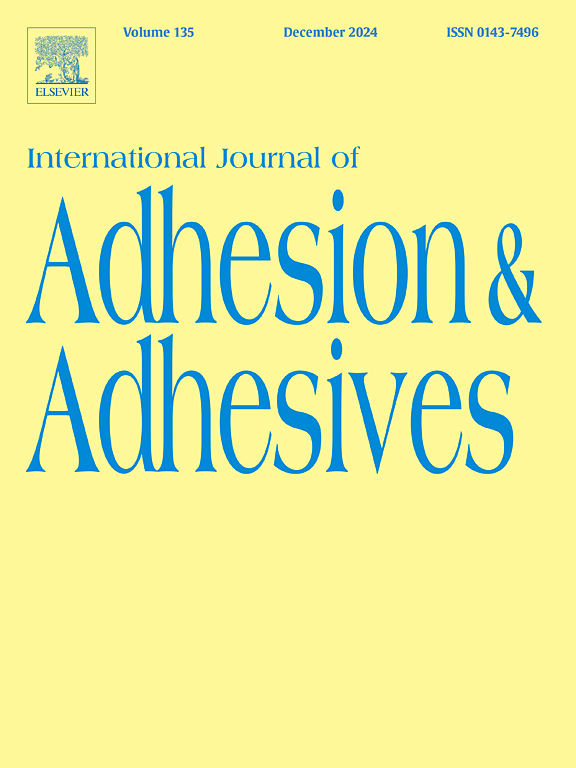Synthesis and properties of superhydrophobic monomer stearyl methacrylate-modified polyacrylate latex pressure sensitive adhesives
IF 3.2
3区 材料科学
Q2 ENGINEERING, CHEMICAL
International Journal of Adhesion and Adhesives
Pub Date : 2024-10-05
DOI:10.1016/j.ijadhadh.2024.103848
引用次数: 0
Abstract
Hybrid surfactants of long carbon chain hydrophobic nonionic emulsifier N-390 and conventional anionic emulsifier CO-436 were utilized in this study to enable successful emulsion polymerization of super-hydrophobic monomer stearyl methacrylate (SMA) together with butyl acrylate (BA), acrylic acid (AA), and 2-hydroxyethyl acrylate (HEA). The influences of SMA on the resulting latex and film properties were thoroughly investigated. Both FTIR and 1H NMR were used to confirm the successful participation of SMA in the emulsion polymerization. The results indicated that with introduction of SMA, the roughness of the latex film increases, while the light transmission decreases. It was also found that with the addition of SMA, contact angle of the latex PSA film increased from 115.1° to 127.2°, while water absorption decreased from 5.76 to 2.89 wt%. DSC curves demonstrated that SMA has participated more in the homopolymerization reaction than in the copolymerization reaction. TGA results showed that the initial decomposition temperature (T5%) of the latex film was increased from 302.8 to 332.7 °C with the increase of SMA dosage from 0 to 20 wt%. Finally, adhesion properties results indicated that loop tack and 180° peel force of the PSA films were decreased from 11.51 to 1.88 N/25 mm and 6.36 to 3.44 N/25 mm, respectively, while shear strength was increased from 732 to 2865 min.
超疏水单体甲基丙烯酸硬脂酯改性聚丙烯酸酯乳胶压敏胶的合成与性能
本研究利用长碳链疏水性非离子乳化剂 N-390 和传统阴离子乳化剂 CO-436 混合表面活性剂,成功实现了超疏水性单体甲基丙烯酸硬脂酯(SMA)与丙烯酸丁酯(BA)、丙烯酸(AA)和丙烯酸羟乙酯(HEA)的乳液聚合。我们深入研究了 SMA 对所得胶乳和薄膜性能的影响。傅立叶变换红外光谱和 1H NMR 被用来证实 SMA 成功地参与了乳液聚合。结果表明,加入 SMA 后,胶乳薄膜的粗糙度增加,而透光率降低。研究还发现,加入 SMA 后,胶乳 PSA 薄膜的接触角从 115.1°增至 127.2°,而吸水率则从 5.76 wt% 降至 2.89 wt%。DSC 曲线表明,SMA 在均聚反应中的参与程度高于共聚反应。TGA 结果表明,随着 SMA 用量从 0 wt% 增加到 20 wt%,胶乳薄膜的初始分解温度(T5%)从 302.8 ℃ 升高到 332.7 ℃。最后,粘附性能结果表明,PSA 薄膜的环粘力和 180° 剥离力分别从 11.51 牛顿/25 毫米和 6.36 牛顿/25 毫米降至 1.88 牛顿/25 毫米和 3.44 牛顿/25 毫米,而剪切强度则从 732 分钟增至 2865 分钟。
本文章由计算机程序翻译,如有差异,请以英文原文为准。
求助全文
约1分钟内获得全文
求助全文
来源期刊

International Journal of Adhesion and Adhesives
工程技术-材料科学:综合
CiteScore
6.90
自引率
8.80%
发文量
200
审稿时长
8.3 months
期刊介绍:
The International Journal of Adhesion and Adhesives draws together the many aspects of the science and technology of adhesive materials, from fundamental research and development work to industrial applications. Subject areas covered include: interfacial interactions, surface chemistry, methods of testing, accumulation of test data on physical and mechanical properties, environmental effects, new adhesive materials, sealants, design of bonded joints, and manufacturing technology.
文献相关原料
公司名称
产品信息
阿拉丁
Stearyl methacrylate (SMA)
 求助内容:
求助内容: 应助结果提醒方式:
应助结果提醒方式:


